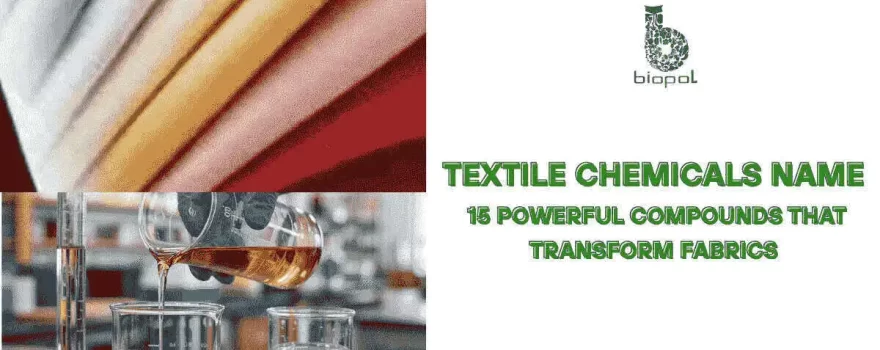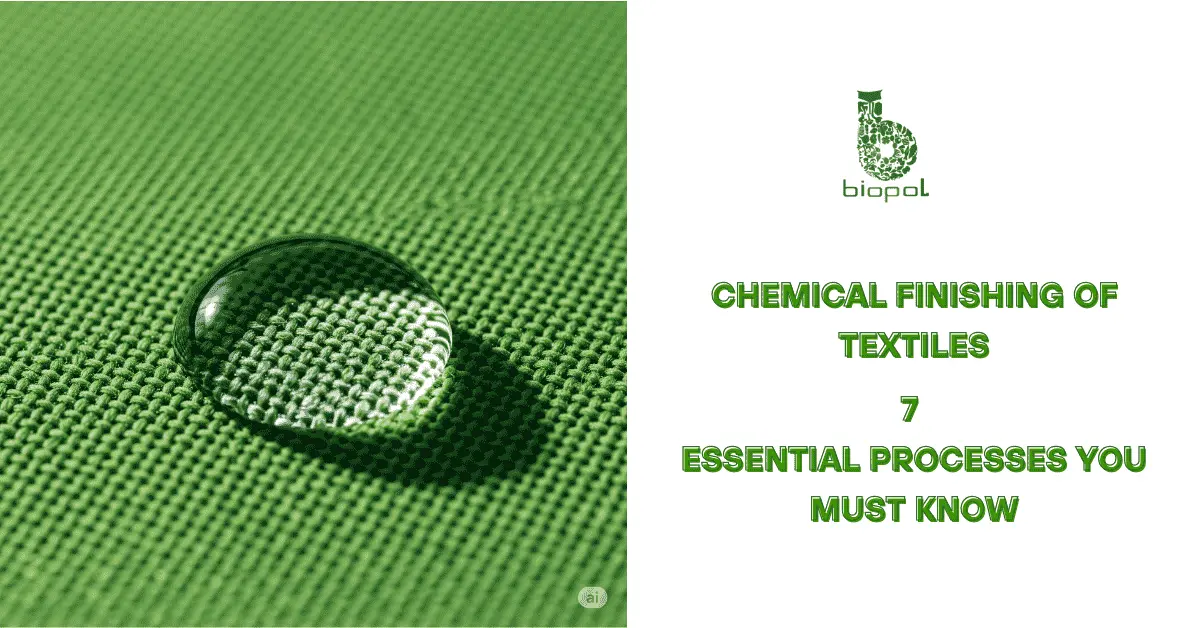
Knowing textile chemicals name list is essential for anyone involved in fabric processing, from manufacturers to quality inspectors. These chemicals play a critical role at every stage—whether it’s preparing raw fibers, dyeing with precision, or finishing with performance-enhancing properties. In this guide, we break down the most important textile chemical names by category, their specific functions, eco-friendly alternatives, and regulatory considerations to help you make informed, sustainable choices.
Table of Contents
Textile Chemicals Name List
textile chemicals name list forms the foundation of any serious conversation around fabric processing today. If you’ve ever wondered how dull yarn becomes vibrant fabric, or how stiff cotton turns soft as clouds, you’re already halfway to appreciating the role of these chemicals. My team has spent years knee-deep in finishing units and dye baths—trust me, there’s no magic wand, just strategic use of very real compounds. From wetting agents that help water do its job better to leveling agents that stop blotchy dye jobs, the textile chemicals name list runs deep. Stick with me—we’re diving headfirst into the chemist’s side of fashion.
Categorization of Textile Chemicals
textile chemicals name list items aren’t just random substances—they serve specific purposes throughout every stage of textile processing. Whether it’s preparing fibers, imparting color, or enhancing fabric performance, each chemical has a crucial role. Think of textile chemicals name list as a well-organized crew, where skipping a member could lead to disastrous results. Here’s a breakdown by function to make sense of this chemical lineup:
| Category | Primary Function | Examples |
| Pre-treatment Chemicals | Preparing fibers and fabrics for subsequent processes by removing impurities. | Scouring agents, desizing agents, bleaching agents, mercerizing agents, wetting agents |
| Dyeing Chemicals | Imparting color to textiles, ensuring even and lasting shades. | Dyes, leveling agents, fixing agents, dispersing agents, pH adjusters, oxidizing and reducing agents |
| Printing Chemicals | Facilitating the application of patterns and designs onto fabrics. | Thickeners, binders, dispersing agents, fixing agents |
| Finishing Chemicals | Enhancing the aesthetic appeal and performance properties of fabrics. | Softeners, stiffening agents, water repellents, flame retardants, wrinkle-free finishes, UV absorbers |
| Specialty Chemicals | Providing specific functionalities beyond basic processing. | Antimicrobial agents, antistatic agents, soil-release agents, flame retardants |
| Processing Auxiliaries | Assisting in various wet processing stages by optimizing conditions and avoiding defects. | Defoaming agents, sequestering agents, emulsifiers |
Each category represents a vital part of the textile process, contributing to the final product’s quality, functionality, and appeal.
Textile Chemicals Name List: Pre-treatment
textile chemicals name list isn’t just jargon—they’re the vital prep work that gets raw fabric ready for dyeing and finishing. Pre-treatment chemicals ensure fabrics are clean, uniform, and ready to take on color. Without them, you’d end up with uneven colors or fabric defects.
Here’s a breakdown of Textile Chemicals Name List pre-treatment chemicals and their applications:
| Chemical Name | Function | Typical Application |
| Wetting Agents | Lower surface tension for better absorption. | Used before scouring or bleaching to ensure even absorption. |
| Desizing Agents | Remove sizing materials (starches, gums) from weaving. | Applied in initial washing to eliminate fabric coating. |
| Scouring Agents | Remove natural oils, fats, and waxes from fibers. | Prepares fabric for uniform dyeing. |
| Bleaching Agents | Whiten fabric by removing natural colorants. | Commonly hydrogen peroxide used on cotton or linen. |
| Mercerizing Agents | Improve strength, luster, and dye affinity. | Sodium hydroxide treatment under tension. |
| Sequestering Agents | Bind metal ions that interfere with processing. | Added during scouring to prevent stains or uneven dyeing. |
| Antifoaming Agents | Reduce or prevent foam formation. | Keeps machines running smoothly during high agitation. |
Pre-treatment chemicals are essential for ensuring the fabric is properly prepared for dyeing and finishing. Skip this step, and the entire process could fall apart.
Textile Chemicals Name List: Dyes & Auxiliaries
Dyeing is a crucial step in textile processing where raw fabric is transformed into vibrant, color-rich material. Achieving that perfect, long-lasting color requires more than just dyes; a range of auxiliaries ensures color evenness, fastness, and longevity.
Here’s a guide to the key textile chemicals name list dyes and auxiliaries used in textile processing:
| Chemical Type | Function | Common Names/Examples |
| Reactive Dyes | Form covalent bonds with cellulose fibers for bright, wash-fast shades. | Procion, Remazol, Cibacron |
| Disperse Dyes | Designed for synthetic fibers like polyester. Small particles disperse in water. | Terasil, Foron |
| Vat Dyes | Insoluble dyes made soluble via reduction, then reoxidized inside the fiber. | Indigo, Vat Orange, Vat Green |
| Acid Dyes | Attach to protein fibers like wool and silk through ionic bonds. | Lanaset, Nylosan |
| Direct Dyes | Apply directly to cellulosic fibers without a mordant. | Direct Red 80, Direct Blue 1 |
| Leveling Agents | Help distribute dye evenly across the fabric. | Anionic/non-ionic surfactants |
| Fixing Agents | Improve dye fastness by anchoring dye molecules to fibers. | Polyamines, Cationic fixing agents |
| Dispersing Agents | Prevent dye particle clumping in water baths. | Naphthalenesulfonate compounds |
| pH Regulators | Control acidity/alkalinity for optimal dye activity. | Acetic acid, Sodium carbonate |
| Oxidizing Agents | Convert leuco form of vat dyes back to the insoluble state in the fiber. | Hydrogen peroxide, Sodium perborate |
| Reducing Agents | Turn vat dyes into soluble leuco form. | Sodium hydrosulfite, Glucose |
These dyes and auxiliaries are essential for achieving vibrant, long-lasting colors and ensuring that fabrics perform consistently over time.
Sustainable Chemical Alternatives in Textiles
Textile chemicals are getting a green upgrade, shifting from traditional, harmful solutions to eco-friendly alternatives. These sustainable options are revolutionizing how fabrics are cleaned, dyed, finished, and softened—without the environmental toll.
Here’s a comparison of conventional chemicals versus eco-friendly Textile Chemicals Name List substitutes:
| Function | Conventional Chemical | Eco-Friendly Alternative | Remarks |
| Scouring | Sodium hydroxide (caustic soda) | Enzyme-based scouring agents | Reduced water and energy use, biodegradable |
| Bleaching | Hydrogen peroxide, chlorine-based | Ozone bleaching, laccase enzymes | Safer effluent, reduced chemical load |
| Dyeing | Synthetic azo dyes | Natural dyes (indigo, madder), low-impact fiber-reactive dyes | Reduced heavy metals, improved biodegradability |
| Fixing Agents | Formaldehyde-based resins | Polycarboxylic acids, formaldehyde-free fixatives | Safer for skin, meets global standards |
| Softening | Silicone softeners | Vegetable oil-based softeners, cationic surfactants | Renewable, non-toxic, safer for aquatic life |
| Flame Retardants | Halogenated compounds | Phosphorus-nitrogen-based, bio-based alternatives | Lower toxicity, safer residues |
| Water Repellents | Perfluorochemicals (PFCs) | C6-fluorinated compounds, wax-based, silicone-free coatings | Compliance with eco-labels |
| Anti-microbial Finish | Triclosan, silver nanoparticles | Chitosan, zinc-based, herbal extracts | Non-toxic, biodegradable, safe for long-term contact |
Adopting these green alternatives improves fabric quality while reducing environmental impact. Sustainable choices deliver performance and safety without the negative effects of traditional chemicals. Cleaner water, safer products, and happy customers—this shift is good for business and the planet.
Compliance, Labelling & (SDS) Considerations
Textile Chemicals Name List is more than just identifiers—they carry critical regulatory, safety, and liability information. Compliance with laws and proper documentation is crucial for avoiding fines, accidents, or delays.
| Regulation | Region/Scope | Key Requirements |
| REACH | European Union | Registration, evaluation, and authorization of chemicals. Safety data must be supplied throughout the supply chain. |
| GHS | Global (UN standard) | Unified system for classifying and labeling hazardous chemicals with pictograms, signal words, and hazard statements. |
| OSHA HCS | United States | Requires SDS availability and chemical labeling in the workplace. |
| BIS Certification | India | Safety and performance standards for regulated chemicals. |
Regulatory Compliance Essentials
Labelling Requirements
Chemical containers must include:
- Chemical name (INCI/CAS standard)
- Hazard pictograms (GHS-compliant)
- Signal words (e.g., Danger, Warning)
- Precautionary statements
- Manufacturer contact details
- Batch number and production date
- Storage and handling instructions
Safety Data Sheet (SDS): 16 Key Sections
An SDS must include:
- Identification
- Hazard Identification
- Composition/Ingredients
- First-Aid Measures
- Fire-Fighting Measures
- Accidental Release Measures
- Handling and Storage
- Exposure Controls / PPE
- Physical and Chemical Properties
- Stability and Reactivity
- Toxicological Information
- Ecological Information
- Disposal Considerations
- Transport Information
- Regulatory Information
- Other Information
Proper compliance and accurate SDS are essential for worker safety, regulatory adherence, and smooth business operations.
Use Different Chemicals Textile Chemicals
It would serve one well to know how to use different chemicals textile chemicals if they are in the textile chemicals industry. Different textile chemicals serve unique purposes across the production process. Pretreatment uses wetting agents and detergents to clean fibers. During dyeing, leveling and dispersing agents ensure even color distribution. Fixing agents lock in dyes, while softeners enhance texture. In finishing, wrinkle-resistant and water-repellent chemicals improve fabric performance. Each chemical plays a specific role in enhancing durability, appearance, and functionality, making textiles suitable for diverse industrial and consumer applications.
Conclusion
Choosing the right textile chemicals is key to enhancing fabric quality and manufacturing efficiency. Each chemical improves specific properties like durability, color fastness, and texture. Opting for sustainable, compliant chemicals supports better performance, safer working conditions, and aligns with eco-friendly industry trends, boosting both product appeal and long-term sustainability.
Frequently Asked Questions
Which chemical is used in textiles?
A wide range of chemicals is used in the textile industry depending on the process. Commonly used textile chemicals include:
- Wetting agents (for better fabric absorbency)
- Scouring agents (to remove oils and waxes)
- Dyes (for color)
- Softeners (to improve fabric feel)
- Fixing agents (to lock in color)
Each chemical serves a specific purpose in making fabrics clean, colorful, soft, or durable.
Which chemicals are used in dyeing?
Key chemicals used in textile dyeing include:
- Dyes: Reactive dyes, direct dyes, disperse dyes, vat dyes, acid dyes
- Leveling agents: Ensure even dye distribution
- Fixing agents: Improve color fastness
- pH regulators: Such as acetic acid or sodium carbonate
- Reducing agents: Like sodium hydrosulfite (for vat dyeing)
- Dispersing agents: Prevent dye clumping
These chemicals ensure that colors are vibrant, uniform, and long-lasting on different types of fabric.
What is the use of HCL in the textile industry?
Hydrochloric acid (HCl) is used in textile processing mainly for:
- pH adjustment: To maintain or neutralize acidity during processing
- Neutralization: After alkaline treatments like mercerization
- Cleaning: Removing mineral impurities or scaling in equipment
Its controlled use helps maintain optimal conditions for dyeing and finishing processes.
Also Read: Textile Chemicals: The Secret Sauce Behind Your Clothes

